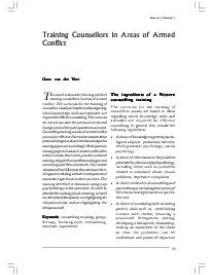Training Counsellors in Areas of Armed Conflict
This article is about the learning needs of starting counsellors in areas of armed conflict. The curricula for the training of counsellors usually are based on ideas regarding which knowledge, skills and attitudes are required for effective counselling. The curricula do not always take the personal needs and backgrounds of the participants into account. Counselling training in areas of armed conflict
can only be effective if the trainer assesses these personal backgrounds and needs and adapts his training approach accordingly. Participants in training projects in areas of armed conflict often
need a concise, short-term, practice-oriented training, stripped from professional jargon and connecting with their, sometimes, very modest educational level. Moreover, they need some form
of support in dealing with the consequences of traumatic experiences in their own lives. The training therefore is education and group psychotherapy at the same time. In order to describe the working of such a training, we need two theoretical descriptions: one highlighting the educational side, and one highlighting the therapeutic side.
Geachte bezoeker,
De informatie die u nu opvraagt, kan door psychotraumanet niet aan u worden getoond. Dit kan verschillende redenen hebben,
waarvan (bescherming van het) auteursrecht de meeste voorkomende is. Wanneer het mogelijk is om u door te verwijzen naar de bron
van deze informatie, dan ziet u hier onder een link naar die plek.
Als er geen link staat, kunt u contact opnemen met de bibliotheek,
die u verder op weg kan helpen.
Met vriendelijke groet,
Het psychotraumanet-team.
Reference:
Guus van der Veer | 2003
In: Intervention: the international journal of mental health, psychosocial work and counselling in areas of armed conflict, ISSN 1571-8883 | 1 | 1 | 33-43
http://www.interventionjournal.com/sites/default/files/van%20der%20Veer.pdf
In: Intervention: the international journal of mental health, psychosocial work and counselling in areas of armed conflict, ISSN 1571-8883 | 1 | 1 | 33-43
http://www.interventionjournal.com/sites/default/files/van%20der%20Veer.pdf


